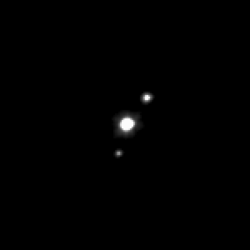 2005 CB79 among other Haumea family objects | |
| Discovery [1] | |
|---|---|
| Discovered by | M. E. Brown, C. A. Trujillo, D. L. Rabinowitz |
| Discovery date | 6 February 2005 |
| Designations | |
| 2005 CB79 | |
| Cubewano (MPC) [2] Extended (DES) [3] | |
| Orbital characteristics [4] | |
| Epoch 13 January 2016 (JD 2457400.5) | |
| Uncertainty parameter 4 | |
| Observation arc | 5083 days (13.92 yr) |
| Aphelion | 50.062 AU (7.4892 Tm) (Q) |
| Perihelion | 37.231 AU (5.5697 Tm) (q) |
| 43.647 AU (6.5295 Tm) (a) | |
| Eccentricity | 0.14698 (e) |
| 288.36 yr (105324 d) | |
| 319.66° (M) | |
| 0° 0m 12.305s / day (n) | |
| Inclination | 28.606° (i) |
| 112.79° (Ω) | |
| ≈ 5 December 2048 [5] ±3 days | |
| 90.154° (ω) | |
| Physical characteristics | |
| Dimensions | 158 km [6] [7] |
| 6.76 h (0.282 d) | |
| 13.52 h [8] | |
| 0.7 (assumed) | |
| (Neutral) B-V=0.73, V-R=0.37 [9] | |
| 21.1 [10] | |
| 4.6 [4] | |
(308193) 2005 CB79 is a trans-Neptunian object that is a member of the Haumea family. [9]

